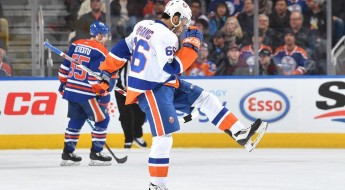Why Edmonton has been unfairly criticized since drafting Taylor Hall and Ryan Nugent-Hopkins
Since the Edmonton Oilers drafted consecutive 1st overall picks Taylor Hall (2010) and Ryan Nugent-Hopkins (2011), they have been considered hockey’s scapegoat anytime a rebuild is brought up.
On the flip side of things, hockey’s rebuilding legends are the Chicago Blackhawks and Pittsburgh Penguins.
Chicago drafted Jonathan Toews 3rd overall in 2006, then Patrick Kane 1st in 2007; becoming Champions of hockey within 5 years of beginning their rebuild.
Pittsburgh was almost identical, drafting Evgeni Malkin 2nd in 2004 and then Sidney Crosby 1st in 2005. They would win their first Stanley Cup in 2009, also within 5 years of their franchise changing first overall pick.
So what’s the difference? What happened with Edmonton that has kept them from making the jump? Or even a leap? Why was Pittsburgh able to make the playoffs one single year after drafting Crosby first? How was Chicago able to hoist the Cup so quickly after ending their playoff drought just one year prior?
There are a couple of factors.
People tend to think a rebuild starts the season where you sell all of your veterans at the trade deadline, and go get yourself a 1st overall pick. Or at least a top 3. But it’s not always the case.
Another factor that seems obvious but is often overlooked is how good are the veterans at the time of your first overall pick? I mean, having Mario Lemieux, John LeClair, Mark Recchi and Sergei Gonchar to work with when you’re 18 seems a little bit better than Ales Hemsky, Jason Strudwick, and Shawn Horcoff. Playing in the NHL as an 18-year old and having former superstars to be your role model and mentor is an obvious advantage; you come straight into a culture of professionalism and work ethic and can simply fit in as a teenager. You don’t have to set the bar or standard, someone else already is.
The other component is quite simply who did they get and what do they bring to the table? Was it Sidney Crosby? Jonathan Toews? Or Taylor Hall?
Since Sidney Crosby has been long been regarded as a generational talent we’ll compare the difference between getting Jonathan Toews and Taylor Hall as your first rebuilding pick.
Now both are excellent players of course, but they’re also completely different players. One of the reasons that Edmonton’s rebuild is perceived to be lagging is because quite plainly, Jonathan Toews is a better leader than Taylor Hall. That’s no fault of Hall since Toews is a superior leader to most, but team’s tend to take quicker rebuilding strides if their young superstars are also leaders and captain material. Crosby and Toews were both exceptional in that regard, leaving it looking a little misleading for the NHL’s next basement dwelling team embarking on a full rebuild (the Oilers). Chicago and Pittsburgh demonstrated that after getting top picks in a row, you should win a Stanley Cup very quickly. Since their successes happened in back to back years, the standard for a rebuilding franchise was set remarkably high, but maybe we all didn’t realize just how exceptional it was.
Let’s dig a little deeper.
When Chicago drafted Jonathan Toews in 2006, he wasn’t coming into the NHL with no one to build around. By the time he and (freshly chosen first overall pick) Patrick Kane made the team in 2007, the team already had a number of improving 23-26 year old players. The 18 and 19 year old phenoms joined the league with already established NHL talent such as Patrick Sharp, Duncan Keith, Brent Seabrook, Andrew Ladd, Dave Bolland, Dustin Byfuglien, and Corey Crawford.

Winnipeg’s Jonathan Toews, captain of the Chicago Blackhawks, hoists the Stanley Cup for the third time in his young career. Image courtesy of melfortjournal.com.
The team had also drafted well prior to adding Kane, where they had Nick Hjalmarsson, Bryan Bickell, and Troy Brouwer all developing in the wings. Say what you want about Bickell’s value nowadays, but there’s no forgetting that he was instrumental in their 2012 Cup win, scoring 9 goals and 17 points in the 23 games.
It seems like things were already looking up for the Hawks, even before they drafted franchise cornerstones in Toews and Kane.
In a similar fashion, prior to the Penguins selecting Sidney Crosby with the top selection in 2005, they had been bad for so long that they already had some young players ready to incorporate.
They drafted Marc-Andre Fleury first overall in 2003, and had recent first round picks Ryan Malone, Ryan Whitney, Brooks Orpik, Colby Armstrong and a young man named Evgeni Malkin all ready to make the jump. The Pens surely had plenty going for them before Crosby. Throw later picks like Kris Letang, Max Talbot, and Rob Scuderi into the mix, and you see that Pittsburgh already had quite a jump on developing into a competitive squad before scooping up Crosby.

Pittsburgh Penguins’ Sidney Crosby reacts as he takes the Stanley Cup after defeating the Detroit Red Wings 2-1 to win Game 7 of the NHL hockey Stanley Cup finals in Detroit. Image courtesy of www.virtualmuseum.ca.
And those are just the core younger pieces.
As an 18 year old Crosby had an immense veteran presence around him, with Sergei Gonchar, Mark Recchi, John LeClair, Zigmnund Palffy, and of course, Mario Lemieux leading the way. Most would bet that Crosby didn’t have to go into that room right away and be the de facto leader of the dressing room. He was given the opportunity to have it shown to him, which is always the best situation.
Four years later and Crosby would make a second consecutive trip to the Cup finals, captaining his team to Hockey’s Holy Grail at just 22 years of age.
So, on top of Chicago and Pittsburgh drafting exceptional leaders and not just talented hockey players, they also had about 5 previous years of stockpiling draft picks and developing them. In the case of the Penguins, they also had a trio of legendary veterans to lead the way, instrumental in showing Crosby how to be the captain he has become.
Now let’s take a look at Edmonton, and you may be surprised at just how different the hand they were dealt was.
When Edmonton drafted Taylor Hall in 2010, the veteran group was Shawn Horcoff, Ales Hemsky, Tom Gilbert, and Andrew Cogliano.
Hm.
It sounds a little meek compared to the other two teams, but in the four years prior to drafting Hall the Oilers actually weren’t too bad, averaging 85 points over that span, and of course making their surprise Cup run in 2006. They barely missed the playoffs twice, and began condemning themselves to the purgatorial position of too good to get top picks, and too bad to make the playoffs.
The group really wasn’t that bad, until eventually overachieving veterans Shawn Horcoff and Ales Hemsky were no longer able to produce as top line players, and they they fell hard.
Real hard.
But is it really Edmonton’s fault they haven’t been able to win a Cup 4 years after drafting first overall?
Since a new era of hockey began post-2005 lockout, a lot of people put some unfair projections on Edmonton since Chicago and Pittsburgh had remarkable turnarounds, drafting generational talents and leaders after years of previous futile. Edmonton’s path, quite plainly, was just different.
With all due respect to Taylor Hall, Ryan Nugent-Hopkins, and Nail Yakupov, a Malkin-Crosby back-to-back draft duo or Toews-Kane duo is a hundred times better than any combination of those three. Hall and RNH have high end skill but they’re missing the leadership factor that played such a vital part in propelling the Pens and Hawks to the top so quickly.
Sure, maybe Edmonton hasn’t done the greatest job developing their players (or drafting beyond the first round), but we also need to understand that when comparing rebuilds, an obvious critical factor is who they get with their top picks. Hall and Nugent-Hopkins just aren’t cornerstone pieces, while Pittsburgh and Chicago’s guys were. They also didn’t have much support when they came into the league.
They are completely different cases.
However, let us not forget that Edmonton now has Connor McDavid.
McDavid brings to the NHL the ingredients that were lacking in Edmonton’s previous three first overall picks. Not only does he obviously have a generational skillset, but just based on the fact that he will have the ability to lead by example with elite point producing, you know it shouldn’t be too hard to become the leader the Oilers have been missing. Combining that with the continued maturity of Hall and RNH, and the Oilers are slowly starting to have the elements of a playoff caliber hockey club.
So how does Connor McDavid sound coming in with Hall, Nugent-Hopkins, Yakupov, Jordan Eberle, Leon Draisatl, Benoit Pouliot, Darnell Nurse, Oscar Klefbom, Justin Schultz, Cam Talbot, Andrej Sekera, and Griffin Reinhart?
Maybe a little bit better than Taylor Hall coming into the league with Horcoff, Hemsky, Sam Gagner, Sheldon Souray, Dustin Penner, and Fernando Pisani.
We can now compare Edmonton’s rebuild in the same light as Chicago and Pittsburgh’s with a pure heart.
We were all judging Edmonton’s rebuild progress based on the idea that Day Zero of their rebuild was the day they drafted Taylor Hall.
But based on Chicago and Pittsburgh’s rebuild, maybe Day Zero was really when they drafted Connor McDavid.
It might sound completely crazy, particularly with their current 4-8 start, but if the above trends are true in relation to Pittsburgh and Chicago, Edmonton might just win a Stanley Cup in 4 years.



Leave a Comment